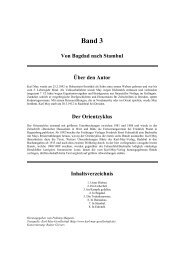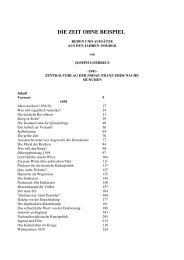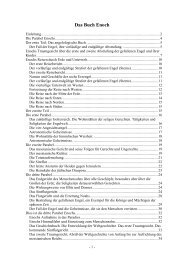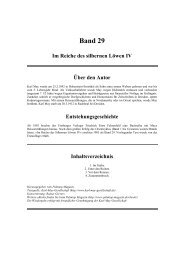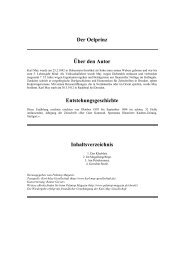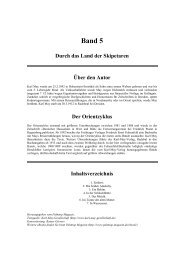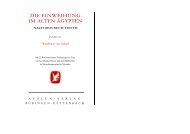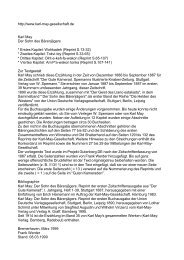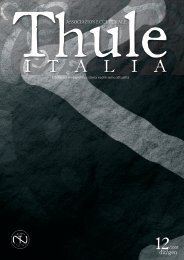Hitler's Baby Division
Hitler's Baby Division
Hitler's Baby Division
Create successful ePaper yourself
Turn your PDF publications into a flip-book with our unique Google optimized e-Paper software.
<strong>Hitler's</strong> <strong>Baby</strong> <strong>Division</strong><br />
"The <strong>Baby</strong> <strong>Division</strong>" was more than a cynical epithet, born of desperation and<br />
a sense of foreboding doom. It brought the whole symbiotic relationship<br />
between the Hitler Youth and the Elite Echelon to its final symbolic and actual<br />
conclusion. The connection between these two Nazi generations, the process<br />
of socialization under the Nazis, and the ultimate implications of the HJ SS<br />
alliance, expressed in numerous small ways at home and on the battlefield,<br />
was compressed within the confines of a single combat division, deliberately<br />
patterned to take full advantage of what was thought to have been achieved<br />
by these key affiliates of the national socialist movement. A thirst for<br />
action, increasingly protomilitary as the uncertain prospects of the war<br />
revealed themselves, changed the Hitler Youth into a school for soldiers at<br />
the end. Exploiting this incubator of ideologically drilled warriors, the SS not
only extracted a sizeable proportion of its elite troops from this source but<br />
began to think about more specific ways of using the HJ.<br />
Organization, Indoctrination and Training<br />
Creating teenage combat units was not unique, since it had been foolishly<br />
tried in the early days of World War One, when talented and enthusiastic<br />
young volunteers were thrown into battle without adequate training and due<br />
consideration for future officer candidate needs, at Langemarck in Flanders.<br />
Some party leaders and certainly old army veterans remembered this<br />
blunder, but the fanaticism prevailing in the SS and the RJF made those who<br />
made decisions in these matters oblivious to the suggestive precedent which<br />
had been played out in the bloody fields of Flanders. So it was not by chance<br />
that the Hitler Youth <strong>Division</strong> remained closely associated with the Führer's<br />
SS Body Guard, beginning in Berlin's Lichterfelde Barracks shortly after the<br />
"Night of the Long Knives" and ending in the Battle of Caen, the Stalingrad of<br />
the Hitler Youth, the so-called Battle of the Bulge, another sign of<br />
desperation fraught with atrocity, and finally the last ditch efforts to defend<br />
an indefensible Vienna, the portentous scene of Adolf <strong>Hitler's</strong> painful<br />
struggle for manhood.<br />
Hitler’s Body Guard and the Hitler Youth <strong>Division</strong><br />
With peculiarly independent relationships to Himmler and the rest of<br />
the Waffen SS, the Body Guard was an elite within an elite. As a personal<br />
security unit dedicated exclusively to the person of the Fuhrer, the<br />
Leibstandarte gave birth to a unique and exclusive combat division which was<br />
moved from front to front to rescue difficult military situations or to<br />
snatch glory from the jaws of death by benefitting from victories won by<br />
2
others. It was in the forefront of every major military campaign: the march<br />
into the Rhineland, the occupation of Austria and Czechoslovakia, the seizure<br />
of Prague, the attack on Poland, the attack on France, the campaign in the<br />
Balkans, and finally the assault on Russia. The Guard took part in vicious<br />
combat on the Eastern Front and played a significant role in the battle to<br />
retake the city of Kharkov during the month of March in 1943. <strong>Hitler's</strong><br />
private " fire-brigade" heaped laurels of victory on its head and Goebbels'<br />
propaganda mill spread its valorous renown throughout Germany and among<br />
the soldiers of the Allies. Singularly reckless in its style of warfare, the<br />
Guard, not surprisingly, suffered a disproportionately large number of<br />
casualties, requiring as a result perpetual replenishment. It was mainly the<br />
Hitler Youth, of course, which had to furnish the required special cannon<br />
fodder. 1<br />
Special recruiting privileges within General SS Main Sectors had been<br />
given to the Guard as early as 1934. We have already seen that the Guard<br />
also established direct contacts with the Hitler Youth in order to siphon off<br />
the best available young manpower. Many starry eyed young men therefore<br />
joined <strong>Hitler's</strong> Guard before the war began and many more must have been<br />
recruited during the halcyon years of 1939 to 1941, although there are no<br />
available records to document any specific wartime recruiting campaign until<br />
1941. There is little doubt, however, that to become a member of <strong>Hitler's</strong><br />
famous Praetorian Guard fulfilled the ambition of many young idealists in the<br />
Hitler Youth, especially after the inflated exploits of the Guard became<br />
weekly features of Goebbels' newsreel editors. Some of these would-be<br />
heroes, nevertheless, became disappointed and impatient with the slow pace<br />
of promotion in the Guard, as in the Waffen SS generally. In December 1940<br />
a controversy arose in the 12th company of the Guard when two former HJ<br />
3
leaders complained about lack of career opportunity. Dissatisfaction reached<br />
the ever sensitive Baldur von Schirach, who soon registered a protest with<br />
Himmler, pompously demanding disciplinary action against the commander of<br />
the company, SS Captain Hubert Meyer, subsequently chief of staff of the HJ<br />
<strong>Division</strong>. What happened then illustrates how much the SS relied on the HJ to<br />
maintain its war machine. An investigation took place which absolved Meyer<br />
from any prejudicial infraction against former HJ leaders and reaffirmed SS<br />
recognition of HJ experience as preferential consideration for promotion.<br />
Any ill will which this and other incidents like it might have created were soon<br />
forgotten. By the fall of 1941 the RJF agreed to mount special recruiting<br />
campaigns only for the Guard. The Youth Leader promised to mobilize ail<br />
leaders in an effort to solicit some 3,000 recruits, but conditions of 5'8"<br />
height and four-and a-half or twelve-year enlistment periods affected<br />
results. Slightly less than 500 seventeen-year-old boys were taken into the<br />
Guard at this time. 2<br />
After <strong>Hitler's</strong> SS Guard became a mechanized infantry division in 1942<br />
the recruiting campaign was repeated, this time accompanied by special<br />
appeals from Artur Axmann himself. He asserted that only the best<br />
volunteers had served in the Guard for years thus affirming a continuous<br />
relationship and that it was therefore a “particular honor” to serve in a unit<br />
which carried the banner of the Führer. The best Hitler youths “belonged” in<br />
the Body Guard. Although exact numerical results for this second known<br />
campaign are not available, it must have been fairly successful since<br />
subsequent SS recruiting efforts were based on the experiences of 1941<br />
and 1943. 3<br />
Planning, Recruiting and Premilitary Training<br />
4
The idea of creating a Waffen SS armored division composed<br />
exclusively of Hitler youths has been generally credited to Artur Axmann.<br />
Even Himmler seems to have been under this impression for a while. But<br />
Gottlob Berger jealously insisted that it had been his idea. Since he had known<br />
that the SS Operations Office would oppose the notion, he had discussed the<br />
matter with his recruiting personnel and with RJF chief-of-staff Helmut<br />
Möckel, who had been the main defender of the idea from the start.<br />
According to Berger early negotiations were kept secret in order to avoid<br />
premature resistance by Dr. Ernst Schlünder and other youth leaders. The<br />
RJF as a whole apparently revealed little interest until it discovered that<br />
Hitler was enthusiastic about the plan. The idea of mobilizing teenagers in<br />
separate units may have occurred to a number of people, including Berger<br />
and Axmann. Certain army leaders and Göring seem to have entertained such<br />
a project as well. The ambience of “total war,” produced by the monumental<br />
Stalingrad defeat, was fertile ground for such desperate expedients. 4<br />
During a discussion between Berger and Möckel on February 9, 1943, it<br />
was agreed that the division should be formed from seventeen-year-olds.<br />
These were to be prepared in Premilitary Training Camps for six weeks,<br />
spend four additional weeks in the Labor Service and conclude their training<br />
with another sixteen weeks of intensive military drilling under SS auspices.<br />
As a concession to physical immaturity they were to receive special rations<br />
during training. Möckel offered the services of the RJF in securing adequate<br />
reserves without affecting the reinforcement of other SS divisions. Right<br />
from the start it appears that Berger and Axmann competed for the enticing<br />
job of commanding this extraordinary division. In fact Berger offered his<br />
services to Himmler on the day he conferred with Möckel and suggested that<br />
5
Axmann be given inspection rights over division reserves as a mollifier. But<br />
Himmler rejected both of them, telling Berger he understood his wish but<br />
needed him for other things. Axmann's inspection rights were granted. On<br />
the loth Himmler saw Hitler at the Wolf's Lair and discused the project with<br />
him. Three days later he informed Axmann that the plan had made the Fuhrer<br />
happy and that he had authorized immediate commencement of recruiting.<br />
Meanwhile, Hitler had been softened up to consider waiving labor service duty<br />
for HJ <strong>Division</strong> volunteers. 5<br />
A planning conference was held on February 16 at HJ headquarters in<br />
Berlin, attended by Axmann, Möckel, Schlünder, Berger and two members of<br />
the SS Recruiting Office. They agreed to accept volunteers with a minimum<br />
height of 5’6” with a slight reduction for signal units, tank crews and<br />
motorcycle companies. The only other requirements were that the boys be<br />
capable of waging war and possess the HJ Achievement Medal wherever<br />
possible. RJF representatives thought that 30,000 boys could be made<br />
available. Since most of them had already been examined by HJ doctors,<br />
Recruiting Stations could begin mustering within a month. Those found<br />
suitable would be inducted into WELs for a six-week course and go directly to<br />
the division thereafter. This plan could be followed if Hitler meanwhile decided<br />
to exempt recruits from labor service obligations. The conferees also agreed<br />
that boys who had not yet reached their seventeenth birthday could be<br />
accepted, which would necessitate, however, a special arrangement with OKW<br />
or a Führer decree. Seemingly reluctant to accept HJ insistence on<br />
premilitary training, Berger thought the simplest method would be to<br />
assemble the boys in basic training centers close to the area where the<br />
division was to be formed. In lieu of this, the existing 39 WELs, still staffed<br />
by the SS, with a total capacity of 8,000 would have to be pre emptied<br />
6
temporarily for HJ <strong>Division</strong> candidates. The latter were to receive uniforms<br />
and equipment while in the WEL. 6<br />
During the following day the RJF announced these plans to regional<br />
leaders assembled for a regularly scheduled conference in Berlin. Axmann<br />
said that the HJ <strong>Division</strong>, alongside the SS Body Guard, was intended as a<br />
"Guard of the Fuhrer." It would be fully motorized, equipped with the heaviest<br />
weapons and led mostly by HJ leaders. Boys who became seventeen on June<br />
30 could volunteer. Eagerness for action and enthusiasm should be decisive<br />
factors, while parental permission was unnecessary. Recruiters were urged<br />
to accept only boys who were physically fit, spiritually alive and those who<br />
had exemplary records in the Hitler Youth. Earners of the Achievement Medal<br />
and the Marksmanship Medal should receive preference. The recruiting should<br />
be done in such a way s to create a vocational balance among peasants,<br />
workers, artisans and students. There should also be balance between<br />
leaders and rank and file boys. Since the division was not intended to be an<br />
elite combat formation, according to Axmann, it indicates that the precedent<br />
of Langemarck was circumvented at least on the surface. Axmann further<br />
announced that the special WEL courses, another attempt to avoid the<br />
Langemarck syndrome, would begin in April and ordered vigorous recruitment<br />
to begin immediately. HJ regions were asked to produce their contingents by<br />
March is so that SS mustering could be completed fifteen days later. A mere<br />
twenty six days were thus allowed to recruit an entire division, a sign of hope<br />
and haste produced, no doubt, by extreme pressure from Berger's Recruiting<br />
Office. 7<br />
On the afternoon of March 8, while furious recruiting was in progress,<br />
Berger ran another planning session in the Main SS Office. It dealt mostly<br />
with the difficult problem of getting sufficient NCOs and officers for the<br />
7
division. The RJF offered to supply a sizeable proportion of the needed 4,000<br />
NCOs by extracting eighteen-year-old HJ leaders who met SS requirements<br />
and had experience as “war training leaders.” Hitler meanwhile released them<br />
from labor duty if they agreed to become NCO candidates. They were to be<br />
prepared in a special camp at St. Veith (Oberkrain, Austria) as “training<br />
assistants” to aid WEL trainers running courses for regular HJ <strong>Division</strong><br />
recruits. After that they were to undergo NCO training with the Waffen SS<br />
and join the division in the fall. The training at St. Veith was to be done by<br />
Waffen SS reservists. Experienced technical NCOs for the division still had to<br />
be found. Jüttner soon objected strenuously that the latter two groups were<br />
not available in the light of NCO shortages. Berger was willing to send the<br />
proffered HJ leaders directly tn NCO schools, but that would have meant<br />
skipping the WELs for enlisted men and the RJF insisted on premilitary<br />
training. Himmler would have preferred to extract the SS Body Guard from<br />
the front line and have it train the entire 20,000-men HJ <strong>Division</strong>, but since<br />
that could not be done, eighteen-year-old HJ leaders would have to become<br />
NCO candidates as Berger recommended. Subsequently many of them were<br />
supposed to be exchanged for experienced NCOs from the Body Guard.<br />
Himmler also promised to ask Hitler for an order to transfer HJ leaders with<br />
army and air force reserve status to the SS in order to supply the remaining<br />
divisional cadre of noncommissioned officers. Initially the RJF thought at<br />
least half of the needed 840 commissioned officers could be found among<br />
veteran HJ leaders who had front experience as company and battalion<br />
commanders in the army. Himmler believed he could get most of them<br />
transferred to the Waffen SS. The rest would have to come from existing SS<br />
field units. SS personnel chief Maximillian von Herff found some sixty<br />
lieutenants in various SS units who were former HJ leaders and could be<br />
8
shifted to the HJ <strong>Division</strong>, but Hans Jüttner objected to that many transfers<br />
from field units already short on officers. Himmler then stepped in with a<br />
compromise solution. There were 600 former HJ leaders serving as NCOs in<br />
the Waffen SS. They would be required to take accelerated officer-training<br />
and eventually replace active officers to be transferred from the Body<br />
Guard and other SS divisions. 8<br />
While planners threshed about in convoluted schemes and expedients,<br />
no one seems to have anticipated the problems of recruitment soon to be<br />
faced. What they did fear is negative publicity. Hence recruiting began<br />
secretly, because the RJF thought public notice would call attention to the<br />
distasteful memory of Langemarck where very enthusiastic but badly trained<br />
volunteers suffered disastrous losses. As late as November secrecy was<br />
still maintained under threats of prosecution, coupled with the suggestion<br />
that appearance of HJ <strong>Division</strong> units should be called simply Waffen SS<br />
volunteers. When recruitment was set in motion by Axmann in the middle of<br />
February, the HJ ran into surprising reluctance to volunteer, especially<br />
among students of secondary schools, a development the RJF might have<br />
expected had the hostile attitude of students in the WELs been taken into<br />
account. But the RJF plunged on nevertheless. Late in March an agreement<br />
was concluded with the National Business Chamber to allow vocational<br />
students, who would normally nave graduated in the fall, to take premature<br />
examinations in April, thus opening the way for induction into the WEL. For<br />
non-vocational students the problem was more complicated and eventually<br />
required SS influence to reach an agreement with the Ministry of Education.<br />
The RJF had accepted responsibility to negotiate a solution but seems to<br />
have encountered a series of roadblocks. Not until April was Axmann able to<br />
inform regional leaders that volunteers would be granted "preliminary leaving<br />
9
certificates" with the promise that they could finish secondary education in<br />
special courses after the war. This made recruiting among students difficult.<br />
Berger then stepped in and made a more satisfactory agreement with the<br />
Education Ministry by granting “final leaving certificates” to student<br />
volunteers who demonstrated the “ability, resolution and will power of<br />
potential university students.” 9 Regions and districts commenced<br />
recruiting during the third week of February. The Swabian Regional<br />
Directorate, for example, demanded lists of volunteers from districts by the<br />
end of February so that physical examinations could begin on March 12. But<br />
the response was slow. District 312 in Memmingen reported a handful of<br />
volunteers, many of whom did not meet height requirements. Kempten<br />
confronted a variety of problems. The district leader had been able to collect<br />
only seven volunteers, despite vigorous personal efforts. Most boys were<br />
then beginning their third year of vocational training and could not take final<br />
examinations for another two-and-a-half years. They wanted to know what<br />
was to become of them after service in the division. Others were interested<br />
only in the officer corps. Mindelheim was more successful, reporting 15<br />
volunteers, although that was only half of the required contingent. The<br />
leader of this district excused his lack of success by citing the proverbial<br />
unwillingness of peasant boys to volunteer. District 495 in Neuburg reported<br />
a similar number of volunteers, but was able to do so only because it avoided<br />
references to physical examinations, which would have discouraged<br />
volunteering. At Nördlingen fourteen boys volunteered, although some 360<br />
boys born in 1926 lived in that district. Lack of response was attributed to<br />
“parental pressure.” 10<br />
The exact number of boys who volunteered for the HJ <strong>Division</strong> in<br />
Swabia by March 12 is unknown. It must have fallen far short of the required<br />
10
400 before examinations, since these were postponed. While postponement<br />
produced more volunteers, many of them were washed out when<br />
examinations were conducted. Augsburg reported 35 volunteers, but SS<br />
examiners found only twelve suitable. District leaders complained that all 35<br />
should have been suitable and accused the SS Recruiting Station officers in<br />
Munich of assigning some of these boys to other SS armed formations. The<br />
Station chief denied this and counter-charged the HJ Regional Directorate<br />
with packing HJ <strong>Division</strong> recruits with previously mustered volunteers already<br />
assigned to other SS units. As demonstrated by numerous other incidents of<br />
a similar nature, organizational pride and loyalty was deeply ingrained and<br />
frequently interfered with the overall purposes of the HJ-SS alliance. At<br />
Sonthofen some 35 boys volunteered, but only 20 reported for mustering<br />
and a mere 14 eventually marched off to the Premilitary Training camp at<br />
Harburg. 11<br />
Recruiting problems soon forced the RJF to shorten premilitary<br />
training from six weeks to four and postpone the starting date to May. This<br />
became necessary despite the fact that Hitler had meanwhile exempted HJ<br />
<strong>Division</strong> volunteers from compulsory labor service, an expedient adopted so<br />
frequently after 1943 that it practically became a general rule. When<br />
training finally began at Harburg, Swabia furnished only eighty mustered<br />
recruits and eleven “training assistants,” 45 men short of the stipulated<br />
quota. Additional volunteers became available later so that camp director<br />
Kurt Ziegler eventually had around 100 HJ <strong>Division</strong> trainees under his wing, a<br />
fact that gave him no little satisfaction. 12 While premilitary training sessions<br />
got underway the RJF ordered a “supplementary recruiting campaign” for<br />
May. In WEL camps as well as in individual HJ dens the siren calls of strident<br />
SS and HJ recruiters were heard once more. When recruits completed WEL<br />
11
training and transferred to the Waffen SS they were ordered to recruit<br />
personally their friends for the division while on furlough, a device that was<br />
probably more effective than some other forms of persuasion. These<br />
belated volunteers went directly to the reserve units of the division. At the<br />
end of July the RJF allowed the regions to recruit from the second half of the<br />
1926 class. They were allowed to skip premilitary training as well. In all WELs<br />
recruiting meanwhile continued at least through the middle of August. 13<br />
Despite formal safeguards against the use of force many boys must<br />
have been driven to volunteer under extremely coercive circumstances.<br />
Army reserve authorities in Stuttgart, for instance, complained to OKW that<br />
“illegal means” were being used to recruit for a “so-called HJ <strong>Division</strong> to be<br />
presented to the Fuhrer on his birthday.” lt would be erroneous, however,<br />
the report went on, if the Führer were to be “under the impression that he<br />
was dealing with purely voluntary recruits.” Incidents were cited where Hitler<br />
youths had been forcefully “moved” to volunteer. They had been imprisoned<br />
in rooms guarded by SS soldiers until volunteer papers were signed and even<br />
had their ears boxed for failure to respond to SS appeals. The SS Recruiting<br />
Station at Stuttgart denied these charges when Berger was forced to<br />
investigate and claimed it could not find allegedly responsible persons<br />
because the army had given “imprecise information.” one of the incidents<br />
apparently took place at Achern where 220 boys had been assembled for<br />
recruiting purposes. But, since only eighteen had signed volunteer<br />
certificates and a mere thirteen of them were later found to be suitable, the<br />
SS “certainly could not be accused of using force.” Berger dismissed the<br />
whole affair as Just another example of the army “raising a stink against the<br />
SS.” 14 SS General Kurt Meyer subsequently implied, however, that some<br />
youths had not come voluntarily and SS General Frltz Witt, the first<br />
12
commander of the division, ordered an investigation in November 1943 to<br />
determine how many men had been inducted against their will. lt is quite<br />
apparent that many forms of official influence and pressure were used to<br />
compel “volunteering,” at a time when the critical military situation had top<br />
priority. 15<br />
Securing the required number of NCOs for the division proved to be<br />
equally difficult. Originally Axmann had asked regional leaders to enlist at<br />
least 10 percent of their eligible unit leaders as divisional NCO candidates.<br />
Swabia was thus expected to furnish 26 and send them to WEL Kuchberg<br />
near Geislingen in Württemberg for training. The initial response was not<br />
encouraging; only 13 mustered men went to Kuchberg. Most eligible leaders it<br />
appears chose to go to the Labor Service, refused to surrender their<br />
officer-candidate status with the air force and the army, or wanted to finish<br />
formal education first. Recruiting results in Swabia must have reflected<br />
national efforts because at the end of March Axmann issued renewed calls<br />
for NCO candidates. While some regional leaders were afraid their staffs<br />
would be depleted, Axmann no longer cared whether local HJ organizations<br />
collapsed when the need for troops to face military crises was overwhelming.<br />
What clearly also was on Axmann's mind had something to do with ah elite<br />
division which would glorify the martial tradition of the Hitler Youth with his<br />
peculiar stamp on it. 16<br />
Hitler Youth districts already faced severe manpower shortages in<br />
1943. At Kempten, for instance, seven leaders had become officer<br />
candidates for the air force, two had been transferred to a children's camp,<br />
one was employed part time in the local civil administration, one wore<br />
corrective glasses, and a couple of others were too short to qualify for the<br />
Waffen SS. While two leaders were NCO candidates with the SS, they refused<br />
13
to switch to the HJ <strong>Division</strong>, one of them wanting to finish school in order to<br />
pursue university training in engineering after the war, while the other<br />
served as Patrol Service leader and surveillance chief and therefore could<br />
not be replaced. The district leader showed a considerable degree of<br />
exasperation: “If I am to surrender two additional leaders for ‘service in the<br />
east’ then I am faced with a practically leaderless organization. I don't think<br />
it makes any sense to force someone to volunteer.” Other district leaders<br />
faced similar problems. 17 In this situation coercion seemed to be the only<br />
recourse if Axmann's demands were to be met and he in turn was bound by<br />
his commitment to Himmler. Yet draftees, it was recognized, would not<br />
provide the kind of spirit and elan which the division was supposed to have, if<br />
it were to follow in the footprints of <strong>Hitler's</strong> Body Guard. Axmann, clearly<br />
worried about this problem, ordered all WEL directors training NCO<br />
candidates to determine how many of them had been commandeered. The<br />
latter were then submitted to another barrage of propaganda and those who<br />
still refused to volunteer “freely” were finally excluded from the NCO roster.<br />
So in the end the RJF was forced to pick potential NCO candidates from rank<br />
and file recruits born in 1926. This began during the second week of their<br />
training in the WELs. So the manpower squeeze led to an expedient, which<br />
gave the so-called <strong>Baby</strong> <strong>Division</strong> a substantial number of noncommissioned<br />
officers of callow seventeen- and eighteen-year-old youth leading rank and<br />
file soldiers of the same age. 18<br />
Reluctance to volunteer, no doubt, had something to do with<br />
selectivity, since those HJ <strong>Division</strong> recruits who underwent premilitary<br />
training at Harburg revealed high morale and eagerness for combat. None had<br />
to be disciplined and nineteen earned the Marksmanship Medal. The overall<br />
impression, which these boys left behind was extremely good," wrote Kurt<br />
14
Ziegler. Although the course had to be interrupted several times for x-ray<br />
examinations and other routine necessities, these special trainees had not<br />
been discouraged. Some twenty five boys, however, had not yet taken<br />
vocational leaving examinations. These boys could not be called up on June 15<br />
as planned because local authorities could not administer examinations unto<br />
July or August. Another thirty-two could not take their school examinations<br />
for a variety of reasons until the fall. These boys had begged SS leaders to<br />
remove all difficulties and allow them to enlist in June. “This pressure to Join<br />
early,” in Ziegler's words, “was most extraordinary.” Thus, if Harburg was<br />
typical--and there is no reason to believe it was not--the claim made by HJ<br />
leaders that extraordinary pride and elan motivated those who survived the<br />
bureaucratic hassle and became members of the HJ <strong>Division</strong> is correct. 19<br />
At the conclusion of premilitary training all 38 WELs staged uniform<br />
ceremonies, transferring these HJ boys to the Waffen SS. Short speeches<br />
by HJ and SS leaders, followed by rousing renditions of favorite songs like<br />
“Ein junges Volk steht auf” and “Es zittern die morschen Knochen,” 20<br />
accompanied by combined SS-HJ musical units, characterized these martial<br />
events. It was clearly a momentous occasion in a decade of HJ-SS<br />
collaboration. Axmann and Himmler, who spoke at one of these ceremonies in<br />
WEL Wildflecken, expressed the symbolic significance of this mutual<br />
dependency. The Youth Leader spoke first, and somewhat disingenuously:<br />
...My comrades and young volunteers who want to join the units of the Waffen SS,<br />
you are a wonderful demonstration of the attitude and spirit of youth during this<br />
fourth year of war. We all feel the burning desire to create a military unit out of<br />
volunteer comrades from the Hitler Youth. The Führer was delighted with this<br />
wish of his youth. He counted on you and thousands of you responded to our call.<br />
You are the elite of German youth and I am happy and lucky that not one of you is<br />
here except by his own free will....In your unit, my comrades, the soldierly<br />
15
tradition of the Hitler Youth will find its ultimate expression. That is the reason<br />
why all German youths direct their attention to this unit, to you; that is why you<br />
must embody the virtues inherent in the best of Germany's youth. So, we expect<br />
you to be idealistic, selfless, courageous and loyal!<br />
Himmler was less hortatory and more candid:<br />
Since the years of struggle, throughout the years of growth before the war and<br />
during the war years themselves, a tie of particular intimacy and inner<br />
fellowship bound the Hitler Youth and SS together. Not only the time of struggle,<br />
the combat of fists, but much more, the battle of spirits and hearts for our<br />
eternal Germany has brought us together and will forever unite us. Now during<br />
the war ten thousands of Hitler youths have volunteered for the Waffen SS; they<br />
have fought honorably and creditably; many of them became casualties. The class<br />
of 1925 participated in the great Battle of Kharkov courageously and<br />
successfully. It can be said in all candor that half of the Waffen SS divisions<br />
which reconquered Kharkov were volunteers from the classes 1924 to 1925 For<br />
all of them this difficult battle was the first taste of combat....In these weeks<br />
when the sacrifice of Stalingrad was on every one's mind, when the Russians<br />
mounted massive attacks, your Youth Leader made the decision to offer to the<br />
Führer the best young boys of the new class for a new Waffen SS division. The<br />
Führer agreed happily. After eight years of training in the Hitler Youth, you have<br />
now assembled in your Waffen SS uniform with your old HJ armband. For four<br />
weeks you have lived together, worked together, trained together and prepared<br />
for military service. Today the National Youth Leader has released you from the<br />
Hitler Youth and presented you to the Waffen SS. Now, in your new Waffen SS<br />
uniforms, you will go home on a fourteen-day furlough (stormy applause),.<br />
After a few months in SS barracks you will enter a great formation, an SS<br />
Panzergrenadier <strong>Division</strong>. You will then train some more, loose many drops of<br />
sweat in order to save drops of blood and finally will march alongside your sister<br />
division, the Body Guard SS Adolf Hitler. You will carry the name which the<br />
Führer gave you: SS Panzergrenadier <strong>Division</strong> “Hitler Youth.” 21<br />
FORMATION, MILITARY TRAINING, AND INDOCTRINATION<br />
16
Hitler had originally ordered that the division be organized on June 1,<br />
1943, but disagreements between Jüttner and Berger over officer and NCO<br />
problems and postponement of WEL courses delayed this target date.<br />
Possible delaying maneuvers by OKW and other manpower and supply<br />
agencies, plus unanticipated slowness in recruiting may also have helped to<br />
defer formation until the end of the month. On the l7th Himmler saw Hitler<br />
on the Obersalzberg and informed him that the division was still in the build<br />
up process. By this time it had been decided to use troop facilities at<br />
Beverloo near Brussels as training and organizational headquarters.<br />
Replacements would be supplied by a newly-created Waffen SS infantry<br />
Training and Reserve Battalion 12 to be located at Arnheim. The formal<br />
organizational order was issued on the 24th by Jüttner, who was responsible<br />
for assigning officers, NCOs and men in agreement with the command of the<br />
I. Waffen SS Panzer Korps, created three days later to contain the l2th<br />
Waffen SS Panzergrenadier <strong>Division</strong> “Hitler Youth” and the 1st Waffen SS<br />
Panzer <strong>Division</strong> or Body Guard. 22<br />
During the month of June, while the Body Guard recovered from the<br />
exhaustive Battle of Kharkov, SS Colonel Fritz Witt, chief of its lst Armored<br />
Infantry Regiment, received appointment as commander of the Hitler Youth<br />
<strong>Division</strong>. Typical of an aggressive new breed of young SS officers, the thirty<br />
five-year-old Witt brought with him to Beverloo a select number of officers,<br />
sergeants and technical specialists. The rest of the officers were<br />
transferred from army and SS divisions or activated from reserve status as<br />
the original plan provided. More than half of them must have been former HJ<br />
leaders. A shortage of company commanders, platoon and squad leaders,<br />
was gradually filled when the former “training assistants” arrived from the<br />
17
SS NCO schools. Additional NCO candidates were selected at Beverloo and<br />
trained within the division. Many NCOs were therefore barely a year older or<br />
even the same age as the young soldiers they commanded. 23 In July and<br />
August the first 10,000 boys arrived to commence basic training, while<br />
various units were gradually formed and shaped into battle condition. The<br />
Commanding General of the lst SS Panzer <strong>Division</strong>, Sepp Dietrich, had already<br />
gotten <strong>Hitler's</strong> permission to provide these boys with food rations normally<br />
reserved for combat soldiers, but August Pohl, the chief of the SS Economic<br />
and Administrative Office, arranged to give them special rations much more<br />
substantial than those allotted to workers in heavy industry. 24<br />
By the end of July most top officers had been assigned. Almost all of<br />
them were in their early thirties. To have two battalion commanders merely<br />
26 years old (Bremer and Olboeter) and three other top commanders in their<br />
late twenties (Wünsche, Ford, and Lintz) is unusual enough, but those below<br />
battalion level were nearly all in their early twenties and the bulk of the<br />
enlisted men were seventeen during training and eighteen at the time of their<br />
first combat engagement. It was indeed the “<strong>Baby</strong> <strong>Division</strong>”! 25<br />
18
Commander SS Brigadier General Fritz Witt (35)*<br />
________________________________________________________<br />
25th Pz. Gren. Regiment SS Colonel Kurt Meyer (32)*<br />
I. Battalion SS Major Erwin Horstmann (31)<br />
II . Battalion<br />
III. Battalion SS Major Johann Waldmüller (31)*<br />
26th Pz. Gren. Regiment SS Lt. Colonel Wilhelm Mohnke (31)*<br />
I. Battalion SS Major Bernhard Krause (33)*<br />
II. Battalion SS Captain Gerhard Bremer (26)*<br />
III. Battalion SS Captain Hans Scapini (30)*<br />
Artillery Regiment SS Lt. Colonel Fritz Schröder (36)<br />
I. Section SS Major Erich Urbanitz (34)<br />
II. Section SS Major Karl Bartling (32)<br />
III. Section<br />
Panzer Regiment 12 SS Major Max Wünsche (28)*<br />
I. Battalion SS Captain Thilo Beck (32)<br />
II. Battalion SS Captain Arnold Jürgensen (32)*<br />
Panzer-Jäger (riflemen)<br />
Anti-aircraft Battalion SS Major Walter Ford (28)<br />
Reconnaissance Battalion SS Captain Erich Olboeter (26)*<br />
Signal Section SS Captain Reinhard Klauenreich (30)<br />
Engineer Section SS Captain Max Müller (39)<br />
Reserves Commander SS Captain Rolf Kolitz (30)<br />
Medical Detachment SS Captain Peter Lintz (29)<br />
Administration Battalion SS Major Dr. Wilhelm Kos (32)<br />
The youthful character of the division not only worried the RJF but also<br />
Goebbels, who feared that Allied propaganda might interpret it as a sign of<br />
desperation, which lt clearly was. Allied intelligence did refer to the “<strong>Baby</strong><br />
19
<strong>Division</strong>,” derisively in radio broadcasts and propaganda leaflets, suggesting<br />
the milk bottle as its tactical symbol. Hitler, nonetheless, believed his<br />
youngsters would fight “fanatically” and predicted that the enemy would be<br />
“struck with wonder.” 26<br />
By mid September most divisional sub units had been formed and<br />
training within them was proceeding smoothly. Some 16,000 boys had<br />
reported, although most equipment was still missing. At the end of<br />
September when the division had reached nearly full strength, it still had not<br />
acquired adequate medical services. Some sixty doctors and fourteen<br />
dentists, all former HJ members serving in various military units, were<br />
extracted by complicated negotiations among HJ, SS and OKW officials. Their<br />
services were overdue, for the type of training practiced by the SS seemed<br />
to result in many minor accidents, especially since they were dealing with<br />
extremely young soldiers. The chief of Armored Troops West, Geyr von<br />
Schweppenburg, complained at one point that there was a lack of adequate<br />
training in first aid. More serious diseases plagued some units. The Engineer<br />
Battalion, for instance, reported six cases of infectious hepatitis, eight<br />
cases of diphtheria and two cases of scarlet fever in a single month. Yet, at<br />
the end of October, the division was designated a full-fledged armored<br />
division, instead of an armored infantry division, and a few days later Hitler<br />
ordered that it be fully equipped immediately. 27<br />
In his post-war memoir Kurt Meyer claimed that the youthfulness of<br />
the division was taken into consideration. New training methods “based on<br />
the traditional German youth movement” had been used instead of normal<br />
military practice. Convivial relationships between men and officers had been<br />
encouraged and close ties to parents and home were maintained. There had<br />
been no time for unnecessary drill or parade ground marching, since<br />
20
emphasis had been placed on training under simulated war conditions. This<br />
claim of Meyer's is substantiated by the remaining records, at least as far<br />
as Fritz Witt is concerned, although he seems to have had considerable<br />
difficulty with lower ranking officers in showing equal understanding. Enlisted<br />
men, guilty of minor infractions, were frequently forced to sign ready made<br />
confessions and overpowered by accusations. Some unit leaders transferred<br />
recalcitrant youths to other formations in order to maintain "clean outfits,"<br />
not in itself an unusual practice in any army but certainly of some<br />
significance in a HJ division touted for its pristine qualities. Witt reminded his<br />
officers that they were dealing with very young men whose training had been<br />
inadequate at home and had to be continued by them, providing a kind of<br />
second home for youngsters deprived of normal socialization. Company<br />
commanders should therefore assume a kind of fatherly responsibility and<br />
try to find appropriate training methods. Some serious accidents occurred<br />
when youthful recruits used weapons to even scores in the inevitable<br />
personal disputes. One such incident sent a young soldier to the hospital, but<br />
his adversary was excused on grounds of immaturity. Another recruit was<br />
caught stealing from a Belgian professor. The thief was given a mild<br />
punishment and the professor, whose stolen property had been returned,<br />
was supposed to have been informed of the punishment, but the regimental<br />
commander found that bit of civility to be unnecessary. Valuables in letters<br />
and packages from home were frequently filched, forcing Witt to order close<br />
surveillance of the mails. Despite many warnings by Witt, strange<br />
punishments continued to be practiced by lower echelon officers and NCOs.<br />
Electrifying door handles, shaving heads, and cleaning rifles between one and<br />
three in the morning were types of penalties cherished by some superiors.<br />
Witt forbade threats of heavy punishment for minor disciplinary infractions,<br />
21
fearing that they might lead to ill-considered actions by impressionable young<br />
soldiers. In one incident involving a bizarre self-disciplinary method known as<br />
“Holy Ghost,” a young soldier died. The most sensational disciplinary incident<br />
involved the son of Gauleiter Wilhelm Murr of Württemberg who appears to<br />
have been “invited to commit suicide,” an example his father followed a year<br />
later. In this context it is no surprise to find that some recruits were<br />
actually hostile to the Nazi Party and the SS. The chief of the field court was<br />
finally forced to instruct divisional officers in the goals of proper<br />
punishment. 28<br />
Two months before the division was committed to combat Witt issued<br />
one of his periodic special directives dealing with discipline and order. He<br />
complained that many unit leaders still failed to understand that their<br />
primary duty was to "shape young soldiers into straight and decent SS men.<br />
Many company commanders apparently had forgotten that their charges had<br />
grown up with fathers away at the front and mothers employed, with the<br />
best teachers and most capable HJ leaders on the long list of casualties. Unit<br />
leaders therefore had to become substitute educators. Providing models to<br />
imitate was the best form of instruction and this required daily association,<br />
since the company was the only world these impressionable recruits knew.<br />
Witt then ordered platoon and squad leaders to live in the same room with<br />
their men to show that they cared about their welfare. Such concern was a<br />
soldier's "most beautiful task." Every noncommissioned officer "should<br />
appreciate the valuable German human material entrusted to him." 29<br />
Training within smaller units commenced as soon as recruits arrived at<br />
Beverloo, even though there was hardly any equipment and no uniforms for<br />
some time. In December 1943 and January 1944 training exercises on the<br />
squad, platoon and company level were carried out, since some eighty<br />
22
percent of the required vehicles - all captured Italian machines had finally<br />
arrived. At the end of January infantry companies, tank companies and<br />
artillery batteries began to demonstrate their proficiency by combat<br />
exercises with live ammunition. Sport exercises, tactical instruction and<br />
sandbox instruction for NCOs by company commanders followed. Heinz<br />
Guderian, the General Inspector of Armored Troops, and Field Marshal Gerd<br />
von Rundstedt, the Commander in Chief West, observed some of these war<br />
games and acknowledged a high level of performance according to Kurt<br />
Meyer. Armored infantry companies placed special emphasis on<br />
reconnaissance, night fighting and flexible shifting from attack to defense.<br />
Fully one third of the training time was devoted to nocturnal maneuvers.<br />
Physical exercises were conditioned by consideration for the performance<br />
capacity of young recruits. Communication practice in the area of the I. SS<br />
Panzer Corps near Dieppe revealed the unreliability of the Italian vehicles and<br />
led to their replacement with German made machines by order of the<br />
“highest authority”--presumably Hitler. 30<br />
At least three hours a week were set aside for indoctrination to be<br />
conducted by company commanders for the most part. After eight years of<br />
incessant doctrinal drilling in the Hitler Youth and four weeks of intensive<br />
propagandizing in the WELs, it was still deemed necessary to conduct regular<br />
weekly indoctrination sessions within the division itself. Witt believed, as<br />
most SS officers believed, that the war against Soviet Russia had made it<br />
painfully clear that a “fanatically indoctrinated enemy” could only be<br />
conquered by the "bearer of a superior ideology." Every young soldier<br />
therefore had to know what he fought for. Hence, “attitude, spiritual<br />
strength and emotional power were thought to be the deciding factors in<br />
generally perceived popular wars.” Company commanders were expected to<br />
23
dedicate themselves to this task of indoctrination with vigor and a sense of<br />
responsibility. The themes they used were no surprise: “Germany's demand<br />
for living space,” “the enemies of Germany are the enemies of Europe,” and<br />
similar platitudes familiar to these boys since the age of ten, when most of<br />
them had entered the Jungvolk and ceased to be children. Every opportunity-<br />
-the waking call, roll call, a pause during training, an infrequent free hour--<br />
was to be utilized by officers and NCOs to “clarify and impregnate the weekly<br />
theme.” Aiming to create a fighting force of true believers required that<br />
every man "grasped internally what he fought for.” Callow youths had to be<br />
transformed into men “who lived according to the fundamentals of the SS as<br />
fanatic warriors,” willing to sacrifice all and give no quarter. 31<br />
While some unit leaders appear to have been complacent, most<br />
noncommissioned officers and company commanders performed the task of<br />
indoctrination with alacrity. Hans Jürgen Walles was one such man. The<br />
records of the division contain a set of detailed notes and charts he used to<br />
education his boys in the esoterica of the SS, its history and racial precepts.<br />
He taught his boys that the SS provided security for the people, that it was<br />
the carrier of the people's weapons, beliefs, blood, communal spirit and<br />
political faith. The SS, according to Walles, fought to preserve German<br />
space, race and humanity. He taught what he had been taught and what he<br />
perceived himself to represent. SS Sergeant Walles' personal history was<br />
probably typical of most noncommissioned officers in the Hitler Youth<br />
<strong>Division</strong>. He was the son of a postal inspector, born in 1922 in Wilhelmshaven,<br />
where he attended elementary school, later moving on to the humanistic<br />
Gymnasium in Bremen. Since March of 1933 he had been in the Hitler Youth,<br />
eventually attaining the rank of Gefolgschaftsführer. Without finishing the<br />
Gymnasium he became a "leader-candidate" in the Labor Service and after<br />
24
the conquest of Poland he volunteered to join the SS Body Guard, but had to<br />
wait a year because he was too young, and spent that time working for the<br />
Post Office. In March 1941 he was called up by the Guard, undergoing training<br />
with the 5th Reserve Battalion at Breslau. As an only son he could not be<br />
sent to the front, becoming a trainer instead. He was promoted four times,<br />
becoming a sergeant in July 1943, when he was assigned to the Hitler Youth<br />
<strong>Division</strong>, the restriction on single sons having been dropped. His resolute<br />
dedication to the Nazi and SS cause was never in question, for he symbolized<br />
the kind of loyalty expressed by Commander Witt for his men on the<br />
occasion of <strong>Hitler's</strong> birthday: "With our whole hearts, with all our strength, as<br />
SS men of the youngest division, We promise to dedicate ourselves to the<br />
deciding battles which lie ahead of us in this war." 32<br />
Fritz Witt declared the training period to be concluded on March 16,<br />
1944: “The training situation happily is a good one. Our Hitler youth boys<br />
during these eight months have been transformed into young men Who know<br />
the military craft.” To celebrate the miraculous metamorphosis of the "<strong>Baby</strong><br />
<strong>Division</strong>" Commander Witt ordered that the candy rations thus far issued be<br />
replaced by cigarettes and tobacco. In April the <strong>Division</strong> was transferred to<br />
France and located southwest of Rouen in the area Gace-Bernay-Evreux-<br />
Dreux, the remaining men and equipment being added in the process. If the<br />
<strong>Division</strong> attained prescribed strength--and there is every reason to believe<br />
that it did--by the beginning of June it had some 20,000 men and officers,<br />
177 tanks, 700 machine guns, 70 mortars, 37 infantry guns and howitzers,<br />
40 field and medium guns, 33 antitank guns and over 100 pieces of varied<br />
antitank artillery. Motor vehicles, armored troop carriers and tractors<br />
brought the total to some 2,950 vehicles. We know for certain that the<br />
<strong>Division</strong> had at least twenty more tanks than the average SS Panzer <strong>Division</strong><br />
25
and certainly more than army equivalents. Since the Hitler Youth <strong>Division</strong> was<br />
trumpeted as a “Junior Body Guard” and since Hitler had specifically ordered<br />
that it be fully equipped, there is little doubt that it was one of the better<br />
supplied fighting units of the war. There were always devious ways to acquire<br />
desired officers and equipment if normal channels failed to supply them, as<br />
Witt's most resourceful regimental commander, Kurt Meyer, and his young<br />
subordinate officers, repeatedly demonstrated. 33<br />
One source of strength lay in the HJ origin of the combat personnel.<br />
The tie to the RJF was carefully maintained by assiduous propaganda and by<br />
visits of Youth Leader Artur Axmann, who made at least two formal<br />
inspection tours. During the first visit Witt ordered commanders to discuss<br />
plans with Axmann and had all positions of honor occupied by young men,<br />
making sure that the Youth Leader was accorded the same respect as<br />
Waffen SS generals by special order of Himmler himself. Axmann spent some<br />
time with most battalions and even with smaller units. During the second<br />
visit he brought along Dutch and Norwegian youth leaders, no doubt at the<br />
suggestion of Gottlob Berger who was, of course. eager to influence SS<br />
recruitment in the occupied countries. The RJF also assumed troop welfare<br />
for the <strong>Division</strong> in order “to solidify the special tie of the National Socialist<br />
movement with the <strong>Division</strong>.” Special musical groups, theatrical troupes,<br />
letter writing campaigns and dispatch of packages fell under this program.<br />
lies with individual battalions and smaller formations were later established<br />
by regional HJ directorates. The umbilical cord to the Hitler Youth was to be<br />
maintained at all costs. 34<br />
All of this meticulous care in organizing, training and preparing the<br />
"<strong>Baby</strong> <strong>Division</strong>" was certainly carried out in order to avoid the errors of<br />
Langemarck which hung over these activities as an ominous cloud. It was also<br />
26
done because the planners believed the HJ <strong>Division</strong> could make a difference<br />
by setting an instructive example and reversing the rising tide of defeatism<br />
and cynical indifference among regular army troops. These notions were<br />
soon to be tested when the HJ <strong>Division</strong> experienced its bloody baptism of fire<br />
in a crucial sector of the Battle for Normandy.<br />
1 Stein, The Waffen-SS, 5, 8, 19, 32, 52, 116-8, 200, 205-7; Weingartner, Hitler’s Guard,<br />
passim; Wegner, Hitlers Politische Soldaten, 281.<br />
2 SSFHA/Kommandoamt der W-SS, “Bericht des Gebietsführers Kohlmeyer an den<br />
Reichsjugendführer,” 15.2.1941, T-175/20/2525087-111; RJF/HA l to all Regions,<br />
“Nachwuchs für die Leibstandarte SS Adolf Hitler,” 15.11.1941, T-175/108/2632300; HJ<br />
Gebiet Schwaben, “Eintritt als Freiwilliger in die LSSAH,” Rundschreiben (1.12.1941), T-<br />
580/349/#5; Weingartner, Hitler’s Guard, 69-70.<br />
3 Axmann, "Freiwilligenwerbung für die Leibstandarte SS Adolf Hitler," RB. 22/42K<br />
(13.10.1942), T-81/115/134527; See also Schwaben Gebietsrundschreiben 24/42<br />
(12.11.1942), T-580/348/#2/2; Gebietsbefehl Westmark K 23/42 (14.12.1942), T-<br />
81/101/117153.<br />
4 Berger to Brandt, “Betr. <strong>Division</strong> 'Hitler-Jugend'," Geheime Kommandosache, 3.7.1943, T-<br />
175/108/2631226-7; Himmler to d'Alquen, 30.6.1943, T-175/70/2586531; Himmler to<br />
Schmundt, Geheim, 22.3.1943, T-175/l08/2631233.<br />
5 Berger Aktenvermerk, “Besprechung mit Möckel,” 9.2.1943, T-175/108/2631262-4;<br />
Himmler notes, “Vortrag beim Führer, 10.2.1943,” T-175/94/2615137; “Vermerk für<br />
Frau Bethge,” 18.3.1943, T-175/108/2631239; Himmler to Axmann, Geheim, 13.2.1943,<br />
T-175/100/2631254; Himmler to Berger, Geheim, 16.2.1943, T-175/108/2631245.<br />
6 Berger to Himmler, "Aufstellung der <strong>Division</strong> Hitler-Jugend," Geheim, 18.2.1943, T-<br />
175/108/2631248-51. The two members of the Recruiting Office were SS-Brigadeführer<br />
Heinrich Jürs, head of Amt B1 (Ergänzungsamt) in the Main SS Office (SSHA), and SS-<br />
Sturmbannführer Robert Brill, Jürs' deputy.<br />
7 Reichsjugendführer der NSDAP, “Hitler-Jugend <strong>Division</strong> in der Waffen-SS,” Geheim<br />
Rundschreiben 898/2/1/43 (17.2.1943), T-611/2/426/I.<br />
8 Berger Aktenvermerk, “Besprechung am 8.3.1943,” T-175/108/2631235-8; Berger to<br />
Himmler, "<strong>Division</strong> Hitler-Jugend," Geheim, 9.3.1943, T-175/108/2631234. Jüttner<br />
(SSFHA) to SSHA, “Aufstellung der SS-<strong>Division</strong> Hitler-Jugend,” Geheim, 10.3.1943, T-<br />
175/108/2631241-2; SSFHA to Dr. Brandt, “Betr. HJ <strong>Division</strong>,” Geheime Kommandosache,<br />
11.3.1943, T-175/108/2631240; Berger to SSFHA, “Aufstellung der SS-<strong>Division</strong> 'Hitler-<br />
Jugend',” Geheime Kommandosache, 20.3.1943, T-175/108/2631228-9; Himmler, “Plan<br />
zur Aufstellung der <strong>Division</strong> 'Hitler-Jugend',” Geheim, with copies to Jüttner, Berger and von<br />
Herff, n.d. (1943), T-175/70/2586518-23; Axmann to Himmler, 8.4.1943, T-<br />
175/108/2631230.<br />
9 Axmann to all Regions, 6.4.1943, T-580/347/#2; RJF, Presse und Propaganda Amt,<br />
“Freiwillige der HJ für die Waffen-SS,” Vertraulich, 3.6.1943, T-81/96/110526; RJF,<br />
P.u.P. Amt, “SS-Panzergrenadier <strong>Division</strong> 'Hitler-Jugend',” vertraulich, 9.11.1943, T-<br />
81/96/110458; RJF, Stabsführer Möckel to Regions, “Div. HJ,” 23.3.1943, T-<br />
580/347/#2; Axmann to Leaders of Regions, “Freiwilligenmeldung zur <strong>Division</strong> HJ,”<br />
1.4.1943, T-580/347/#2; RJF/HA IV/Soziales Amt, “Freiwilligenmeldung zur <strong>Division</strong><br />
HJ,” 14.4.1943, T-81/115/134742; Ernst Schlünder to Gebietsführer der HJ Gebiete, “HJ-<br />
<strong>Division</strong>,” 9.5.1943, T-580/347/#2; HJ Gebiet Schwaben, “Lehrabschlussprüfung der<br />
Freiwilligen der <strong>Division</strong> HJ (Reichsnährstandsberufe),” 4.6.1943, T-580/349/#5;<br />
Axmann to Leaders of Regions, “Freiwillige für die <strong>Division</strong> HJ aus Schülerkreisen,”<br />
27
6.4.1943, T-580/347/#2; HJ Gebiet Schwaben, “Schulabschluss der Freiwilligen der<br />
<strong>Division</strong> HJ,” Rundschreiben 15/43 (16.6.1943), T-580/349/#5; RJF to Leaders of<br />
Regions, "Lehrabschlussprüfung der Freiwilligen der SS-<strong>Division</strong> HJ," 22.5.1943, T-<br />
84/241/6599907-9; Berger to Himmler, 27.5.1943, T-175/108/2631243-4.<br />
10 HJ Gebiet Schwaben, "Vordringliche Werbung für die Waffen-SS (Neue <strong>Division</strong>),"<br />
Gebietsrundschreiben 5/43 (26.2.1943), T-580/349/#5. Recruiting reports of HJ Banne<br />
312, 476, 492, 495, and 315 on T-580/348/#2/2.<br />
11 HJ Gebiet Schwaben, "Untersuchungstermine," n.d., T-580/347/#2; HJ Bann Augsburg to<br />
Ergänzungsstelle Süd, "Werbung und Musterung für die HJ <strong>Division</strong>," 27.4.1943; SS<br />
Ergänzungsstelle Süd, “<strong>Division</strong> HJ,” 4.5.1943, T-580/347/#2; Correspondence of<br />
Hauptgefolgschaftsführer Mathes of HJ Bann Sonthofen, March and April, 1943, T-<br />
580/348/#2/2.<br />
12 Victor Brandl to RJF, “Sonderlehrgang HJ <strong>Division</strong>,” 8.3.1943; Voigtländer to Gebietsführer<br />
Schwaben, “HJ <strong>Division</strong>,” 17.3.1943; Schlünder to Gebietsführer Schwaben, “Einberufung<br />
der Freiwilligen für die HJ <strong>Division</strong> in die WEL,” Streng vertraulich, 1.4.1943; Schlünder to<br />
Leaders of Regions, “Einberufung,” Streng Vertraulich, 9.4.1943; Axmann to Leaders of<br />
Regions, "HJ <strong>Division</strong>, Einberufung zum RAD," 20.4.1943; Ziegler to SS Ergänzungsstelle Süd,<br />
"Lehrgang für Freiwilligen der HJ <strong>Division</strong>," 4.5.1943, T-580/347/#2. Brandl, a wounded<br />
army veteran, became wartime chief of the premilitary and physical training bureau of HJ<br />
Region Swabia on 10.11.1942. As a lieutenant in the reserve and HJ Stammführer he worked<br />
with Oberst von Pechmann of the Stellvertretendes Generalkommando of Wehrkeis VII,<br />
headquartered in Munich. He was in charge of call-ups for the Premilitary Training Camps at<br />
this time and later transferred to Hauptabteilung V and promoted to Oberstammführer.<br />
Hauptbannführer Voigtländer was head of the Hauptabteilung Motor HJ in Amt<br />
Wehrertüchtigung, part of Hauptamt II in the Reichsjugendführung in Berlin.<br />
13 HJ Gebiet Schwaben, “Nachwerbung für die HJ <strong>Division</strong>," 28.4.1943; RJF to Führer der<br />
Gebiete, "Nachwerbung für die HJ <strong>Division</strong>," 15.5.1943; Reports of Bann Dillingen, Wertach,<br />
Allgau and WEL Harburg, May 1943; Brandl to RJF, “Betr. HJ <strong>Division</strong>,” 5.6.1943; T-<br />
580/347/#2. Report from the Leader of HJ Gebiet Baden/Alsace, 22.3.1943, T-<br />
175/159/2690436. This Region had recruited 2,502 Waffen-SS candidates by this time,<br />
including HJ <strong>Division</strong> volunteers then still being sought. See also Schlünder to Führer der<br />
Gebiete, "Betr. HJ <strong>Division</strong>," 5.6.1943; Brandl to RJF, "HJ <strong>Division</strong>,” 16.6.1943, T-<br />
580/347/#2; HJ Gebiet Baden, Sonderrundschreiben, 22.7.1943, T-81/99/115688; HJ<br />
Bann Karlsruhe, "Einberufung zur HJ <strong>Division</strong>," 23.7.1943, T-81/99/115721; WEL<br />
Harburg, "Freiwillige für die HJ <strong>Division</strong>," 25.7.1943, T-580/348/#2/2; HJ Gebiet Baden,<br />
"HJ-<strong>Division</strong>," Sonderrundschreiben, 28.7.1943, T-81/100/1 15747; HJ Bann Zabern to HJ<br />
Gebiet Baden, "Betr. HJ <strong>Division</strong>," 2.8.1943, T-81/99/115718; HJ Bann Augsburg, "Betr.<br />
HJ-<strong>Division</strong>," 10.8.1943, T-580/347/#2.<br />
14 Stellv. Generalkommando V, “Werbung für die Waffen-SS,” Geheim, 30.3.1943, T-<br />
175/70/2586789; Ergänzungsstelle Südwest, "Sonderfall Amt B1," Geheim, 30.4.1943, T-<br />
175/70/2586784-7; Berger to Himmler, Geheim, "Werbung für die Waffen-SS," 7.5.1943,<br />
T-175/70/2586783. See also SS-Personalhauptamt to OKW, Geheim, "Werbung für die<br />
Waffen-SS," 25.5.1943, T-175/70/2586774-5.<br />
15 “Panzermeyer” (Kurt Meyer), Grenadiere ( München, 1965), 206. 12. SS Panzer <strong>Division</strong><br />
‘Hitler-Jugend’, “Meldungen von Männern die sich nicht freiwillig zur Hitler-Jugend <strong>Division</strong><br />
meldeten,” 19.11.1943, T-354/154/3798021. For examples of non-voluntary enlistment<br />
see letter of SS-Recruiting Station South to sixteen-year-old Bernhard Ressl of Buchloe near<br />
Kaufbeuren, 27.4.1943, T-611/2/426 I; and B.J.S. MacDonald, The Trial of Kurt Meyer<br />
(Toronto, 1954), 106-7.<br />
16 Axmann to Leaders of Regions, “Sicherung des Unterführernachwuchses für die HJ <strong>Division</strong>,”<br />
9.3.1943, T-580/347/#2; HJ Gebiet Baden, Rundschreiben, 11.3.1943, T-<br />
81/99/115705-6; Schlünder to HJ Gebiet Schwaben, 17.3.1943; Hauptbannführer Walter<br />
28
Ludwig (Stabsleiter of Gebiet Schwaben) to HJ Districts, “Sicherung...,” Streng vertraulich,<br />
19.3.1943; Brandl to RJF, 1.4.1943; T-580/347/#2; See same folder for reports of various<br />
Banne; Axmann to Leaders of Regions, "Sicherung...," 30.3.1943; HJ Gebietsführer Ludwig<br />
Stinglewagner (Schwaben) to Leaders of HJ Districts, “Sicherung...," 31.3.1943; T-<br />
580/347/42. See also HJ Gebiet Baden, Sondereilrundschreiben, 2.4.1943, T-<br />
81/99/115703; RJF, "Sicherung...," 6.4.1943, T-580/347/#2.<br />
17 Bann Kempten to Ludwig, “Sicherung des Unterführernachwuchses für die HJ <strong>Division</strong>,"<br />
8.4.1943; Bann Nördlingen to Ludwig, “Sicherung...,” 10.4.1943; T-580/348/#2/2.<br />
18 Axmann to Leaders of Regions, “Unterführernachwuchs und Freiwillige für die HJ <strong>Division</strong>,"<br />
14.4.1943; WEL Kuchberg to HJ Gebiet Schwaben, “Unterführernachwuchs-<br />
Unterführerlehrgang...,” 16.4.1943; "Aufstellung der tatsächlichen im WEL Kuchberg,"<br />
17.4.1943; T-580/347/#2; “Unterführernachwuchs...," WEL Rundschreiben 4/43<br />
(10.5.1943); T-580/350/#6/I.<br />
19 Kurt Ziegler, WEL III/36, “Arbeitsbericht über den 2. Lehrgang vom 2.5.-30.5.1943,<br />
Sonderlehrgang HJ <strong>Division</strong>,” T-580/351/#7.<br />
20 The song titles can be translated as "A young nation rises" and "The world, its rotten bones are<br />
shaking." The latter was composed by Hans Baumann, a celebrated HJ poet and songwriter who<br />
held important positions in the organization before the war, survived the war, and later won<br />
several prizes for contributions to children's literature, including one from the New York<br />
Herald Tribune. The first verse of the song:<br />
The world, its rotten bones are shaking in fear of a war with the Reds.<br />
But we (Nazis) have rushed that monster, a splendid victory is ours.<br />
We shall continue to march on, even if all be destroyed.<br />
For today Germany heeds us, tomorrow the whole world.<br />
And if the world lies in rubble from the battle<br />
That disturbs us not at all, for we'll just build it up again!<br />
Vernon L. Lidtke, "Songs and Nazis: Political Music and Social Change in Twentieth Century<br />
Germany," in Stark and Lackner, Essays on Culture and Society in Modern Germany (Arlington,<br />
Texas, 1982),193. Stachura, Nazi Youth, 212.<br />
21 Schlünder to Stinglwagner, 10.5.1943 “Feier zur Überführung der Freiwilligen aus der HJ<br />
in die HJ <strong>Division</strong> am 30.5.1943,” WEL-Rundschreiben 4/43 (10.5.1943), T-<br />
580/350/#6/1; "Feier zur Überführung der Freiwilligen in die HJ <strong>Division</strong>, Wildflecken, am<br />
Sonnabend, den 29. Mai 1943, 16:00 Uhr,” T/611/2/426 I; “Rede des Reichsjugendführers<br />
am 29. Mai 1943 in Wildflecken vor den Freiwilligen der Hitler Jugend,” Geheim; "Rede des<br />
RFSS am 29. Mai 1943...," Geheim, T-81/96/110517ff.<br />
22 “Führerbefehl,” n.d. (April 1943?), T-175/108/2631252; Himmler notes, "Vortrag<br />
beim Führer am 17.6.1943," T-175/94/2615102, 2615111; SSFHA, “Aufstellung der SS<br />
Panzer Grenadier <strong>Division</strong> 'HJ',” Geheime Kommandosache, 24.6.1943, T-<br />
175/108/2631214-5.<br />
23 Panzermeyer, Grenadiere, 204-5; Stein, The Waffen-SS, 205-6; Ernst-Günther<br />
Krätschmer, Die Ritterkreuzträger der Waffen-SS (Göttingen, 1955), 22-5. (check newer<br />
edition)<br />
24 Panzermeyer, Grenadiere, 205; Pohl to RFSS, “Verpflegung der Angehörigen der SS Pz. Gren.<br />
Div. 'HJ'," 25.6.1943, T-175/70/2586532-3. Each week they were to receive 3.5 liters of<br />
fresh milk, 1,750 grams of bread, 200 grams of meat, 140 grams of lard, 120 grams of sugar<br />
and 245 grams of “nutrients.”<br />
25 “Führerstellungbesetzung” 31.7.1943, T-175/18/2521572, 2521760. The * indicates<br />
individuals who received the Knights Cross either before or after their assignment to the l2th<br />
SS Panzer <strong>Division</strong>. For short biographies see Krätschmer,Die Ritterkreuzträger der Waffen-<br />
SS. For company lists with birthdates and vocational distribution see T-354/154/3798022ff.<br />
29
26 Panzermeyer, Grenadiere, 204. Helmuth Heiber, ed., Hitlers Lagebesprechungen (Stuttgart,<br />
1962), 334-5, 381; Himmler, "Besprechung beim Führer," 20.9.1943, T-<br />
175/94/2615082.<br />
27 Axmann to Himmler and Axmann to Brandt, "Ärztliche Versorgung der SS <strong>Division</strong> HJ,"<br />
24.9.1943, T-175/70/2586516-7; RFSS/Pers. Stab to SS Sanitätsamt in SSFHA,<br />
22.10.1943; Himmler to Axmann, "Freigabe der HJ-Ärzte für die HJ <strong>Division</strong> 'Hitler-Jugend',<br />
" 1.11.1943; T-611/2/426 I; General der Panzertruppen West, Geheim, order of<br />
23.10.1943, T-354/156/3800265; SSFHA, "Umgliederung der SS Pz. Gren. <strong>Division</strong> HJ,"<br />
Geheime Kommandosache, 30.10.1943, T-175/108/2631208-9; Hitler, "Weisung Nr. 51,"<br />
11.11.1943, in Walter Hubatch, Hitlers Weisungen für die Kriegsführung (Frankfurt, 1962),<br />
234; 12. SS Panzer <strong>Division</strong> Hitler Jugend, Pi. Btl., Truppenartzt, “Meldungen ansteckender<br />
Krankheiten vom 2.12. bis 17.12,1943,” 17.12.1943, T-354/154/3797963.<br />
28 Panzermeyer, Grenadiere, 206-7; Der Kommandeur, "Befehl Nr. 1 über die Behandlung von<br />
Strafsachen," 29.9.1943, T-354/153/3797108; Witt, “Auftreten in der Öffentlichkeit,<br />
Disziplin, Anzug,” 16.11.1943; Zugführer Walles, “Meldung” re “kindliche Spielerei,”<br />
16.12.1943; T-354/154/3797402, 3797630-1; II/Pz. Art. Rgt. 12, “Strafsache gegen SS-<br />
Kan., Erich Kanoniczak,” 31.1.1944, T-175/155/3799143-4; Witt, “Sonderbefehl-<br />
Straftatenverhütung,” 28.4.1944, T-354/154/379900ff; Witt, “Sonderbefehl-<br />
Untergebenen Misshandlung,” 6.2.1944, T-354/153/3797063; Witt, "Sonderbefehl-<br />
'Heiliger Geist'," 6.2.1944, T-354/153/3797080; 12. SS Pz. Div., Chef des Feldgerichtes,<br />
"Zweck des Strafvollzugs," 8.2.1844, T-354/156/3800384; Himmler to Bormann (re<br />
Gauleiter Murr), 11.2.1944, T-175/37/2547379-80; Jochen von Lang, The Secretary,<br />
318; 12. SS Pz. Div., Brü. Kol., “Vernehmungsniederschrift” (re hostility to Nazi Party),<br />
7.3.1944, T-354/155/3799475-6.<br />
29 Witt, “Sonderbefehl,” 12.4.1944, T-354/3797992-3.<br />
30 12. SS Pz. Div., Abt. Ia, Geheime Kommandosache, “Ausbildungsbefehl Nr. 1,” 17.11.1843,<br />
T-354/156/3800267-70; 12. SS Br. Kol., Pz. Btl. 12, “Betr. Belehrung” re consideration<br />
for youthful performance capacities, 29.3.1943, T-354/153/3796978; Panzermeyer,<br />
Grenadiere, 206.<br />
31 12. SS Pz. Div., Abt. IIa, “Die Weltanschauliche Schulung in der SS Panzer <strong>Division</strong> ‘Hitler-<br />
Jugend’,” 22.11.1943, T-354/156/3800397-8; Heck, A Child of Hitler, 1.<br />
32 Pz. Pi. Btl. 12, “Btl. Befehl 25/43,” 14.12.1943, T-354/154/3798224-6; Pz. Pi. Btl.<br />
12, “Ausbildungshinweis,” 28.2.1944, T-354/153/3796924; SS-Unterscharführer<br />
Walles, “Weltanschauliche Schulung,” n.d. T-354/154/3797489-94; “Hans Jürgen Walles-<br />
-Lebenslauf,” 8/II/Btl. 1. Rgt., 1.11.1943, T-354/153/3797417-9; Witt, “Sonderbefehl<br />
zum Geburtstag des Führers am 20. April 1944,” T-354/154/3797983.<br />
33 Witt, “Sonderbefehl,” 16.3.1944, T-354/154/3797994; Chester Wilmot, The Struggle<br />
for Europe (New York, 1963), 202-3, 274; See also T-354/153/3797170; Lionel F. Ellis,<br />
Victory in the West: The Battle of Normandy (London, 1962), 553; Panzermeyer, Grenadiere,<br />
passim.<br />
34 Abt. Ia, “Sonderbefehl zum Besuche des Reichsjugendführers vom 5.12.-7.12.43,” T-<br />
354/154/379800-2; Axmann to Himmler, 10.4.1944, T-611/2/426 I; Witt,<br />
“Sonderbefehl Nr. 4,” 19.11.1943, T-354/154/3797629.<br />
30



